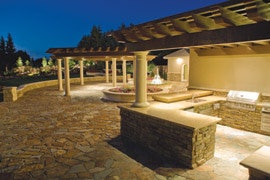
Lucky for us, today's "summer" kitchens are designed around enjoyment, relaxation and the five senses. Outdoor living has become so appealing that - even in a difficult housing market - it's no longer a trend, it's a practice area for many types of design professionals. Landscape architects and landscape designers represent the bulk of those working in this area, but interior designers are increasingly involved in their clients' outdoor spaces. In fact, the American Society of Interior Designers' annual awards program now has a category for outdoor rooms. Manufacturers of furniture, textiles and appliances have committed to the category, as well.
While some pool builders may worry that increased interest by other trades might mean more competition, the more likely outcome is more work for everyone and higher satisfaction for customers. Another plus for pool builders is the wealth of creative and quantitative energy that's been applied to the category. Consumers are exposed to more and better ideas for their own spaces through media like HGTV or Discovery Channel or shelter magazines, and that creates demand.
A number of organizations have put forth research and forecasts from their industries' perspectives to help illuminate what homeowners are looking for in outdoor living spaces. While styles, patterns and colors are regional, this data taken together draws a national picture of the category that's both instructive and encouraging.
A Big Playing Field
First of all, the universe of potential customers for outdoor-living products and services is large. According to a 2007 American Home Furnishings Alliance survey, 91 percent of Americans have some sort of exterior living spaces that are part of their homes. Two-thirds of them spend time relaxing in their outdoor spaces at least once a week. Eighty-two percent used their outdoor rooms for entertaining at least once last year while 24 percent entertained outdoors once a week. Dining al fresco is popular among the 27 percent who sit down to a meal in their outdoor spaces at least once a week and 75 percent said they dined outdoors at home at least once last year.Perhaps the most encouraging feedback was from the 79 percent who said they would like to spend more time in their outdoor spaces than they have in the past.
Second, Upscale households are still spending money despite the overall gloomy economic forecast. According to a recent survey in Casual Living, 38 percent of "upscale" homes added a finished outdoor room last year. Residential Design & Build reported that the average backyard makeover cost $50,000 to $100,000. PK Data surveyed a sample of landscape designers, contractors, pool builders and backyard retailers and found that all reported their outdoor-room projects were up from 40 to 100 percent.
Following are the forecasts from the landscape architecture profession and the barbecue industry.
Hot Off The Grill
The Hearth, Patio & Barbecue Association announced a record-breaking year in 2007 as grill shipments exceeded 17.4 million units. Leslie Wheeler, HPBA director of communications, says that grill customers want convenience and ease of use in sophisticated state-of-the art products. "The highest shipment numbers in more than 20 years and the majority of consumers grilling year-round," has spawned a flurry of new products and definable trends within the category, according to Wheeler. These are the trends Wheeler says are driving sales in 2008."You"-nique Grills: Manufacturers are addressing individuality and needs of grillers by adding distinctive features. Attachable sushi bars, portable woks, cast iron griddles and advanced control tools, such as a grill-surface temperature indicator that tells when to flip and serve, are emerging as popular features that allow consumers to prepare a variety of new and favorite foods on the grill. And grillers can even go as far as personalizing add-on features; for example, the legs and handles of portable woks can be customized to feature favorite animals, characters or building shapes.
Outdoor Living: It's well known in the pool and hot tub industry, but good to hear it from another source that "Outdoor living continues to reign as consumers remodel backyard patios and build outdoor kitchens to make the outdoor experience more enjoyable," says Wheeler. "The [barbecue] industry is also seeing outdoor rooms becoming an extension of the family and living rooms. The transition from the interior of the home to the exterior living space is being designed with wider doorways to tie the two environments together. Outdoor furniture is being upgraded to coordinate fabrics from inside to outside.
"At the forefront of outdoor-living are baby boomers. With the most disposable income, boomers are building outdoor kitchens as a popular way to upgrade their homes without having to move," says Wheeler. "Outdoor kitchens are becoming a standard feature in new-home plans, as opposed to an optional room."
Grill Gone Green: "As consumers go green, so has their grilling," Wheeler says. As consumers demand more-environmentally responsible products, grills that use less propane and more eco-friendly charcoal are easier to find. At the same time, consumers are choosing natural tones for outdoor living fabrics, perhaps a nod to environmental awareness.
Making Room
The American Society of Landscape Architects represents perhaps the most influential design professionals when it comes to outdoor living spaces. Following is the ASLA market forecast for 2008.No longer content with just the outdoor kitchen, homeowners will add entire great rooms outdoors this year according to a survey of leading members of ASLA. On the commercial side, clients will focus on low-maintenance landscapes, mitigating storm-water runoff, and earning LEED certification.
Conducted in December 2007, the informal poll asked leading landscape architects about the top residential and commercial trends for 2008. On the residential side, outdoor kitchens and fire pits continue to be popular requests. However, more and more homeowners are asking for outdoor "great rooms" incorporating the living room, dining room and kitchen for family gatherings and outdoor entertaining.
"Homeowners are reconnecting with their outdoor space, often in creative and imaginative ways," says Perry Howard, FASLA, president of ASLA. "It's no surprise that people want to take elements that work so well inside their home and recreate them outside."
Additionally, landscape architects anticipate a revival of the garden. Lawn maintenance costs - especially irrigation - will lead homeowners toward water-saving features and away from traditional grass lawns. Gardens and landscapes that incorporate more native and drought-resistant plants can make a home's landscape significantly more sustainable.
Cost mitigation will continue to concern commercial clients, too. They will ask for low-maintenance native and drought-resistant plants to lower irrigation requirements and porous paving and bioswales to manage storm-water runoff.
These elements fit into another trend for 2008: more commercial clients obtaining certifications from green rating systems, such as the U. S. Green Building Council's LEED program.
"More and more landscape architects see a demand for incorporating and quantifying sustainable design - especially on the commercial side," Perry adds. "This is one reason we are creating the Sustainable Sites Initiative, which will give clients and designers the tools and best practices for designing energy-efficient, environmentally friendly landscapes." Sustainable Sites is a partnership between ASLA, the Lady Bird Johnson Wildflower Center and the U.S. Botanic Garden to create a green rating system for sustainable landscape design in all types of projects.
In addition to sustainable design, commercial clients will incorporate more gardens, walking paths, or other methods for people to relax and enjoy the outdoor environment. More of these spaces will utilize the existing natural features and vegetation, as well.
The majority of landscape architects remain busy despite trouble in the housing market, according to an ASLA survey. More than six in 10 firms reported steady or increased work, and nearly four in 10 firms planned to hire in the upcoming quarter.
As with the third quarter of 2007, the fourth quarter saw the majority of firms staying busy despite larger housing market troubles. Fifty-eight percent of respondents described their billable hours as either well-above average (6 percent), slightly above average (25 percent), or average (27 percent). Thirty percent said their hours were slightly below average, and 10 percent said well below average. When asked to compare fourth quarter 2007 with fourth quarter 2006, 61 percent said their hours were either higher (31 percent) or about the same (30 percent); 36 percent said that compared to 2006, their hours were lower.
Firms shared their outlook and concerns in the survey, as well. One small midwestern firm said its outlook for billable hours is "improving significantly," while a midsized northeastern firm said it has "just started receiving much larger commissions." A large national firm said, "The housing market had a major effect on our backlog of work. We are currently developing more relationships with commercial developers." Other firms spoke of their experiences with seasonal construction slowdowns, concerns about inflation and energy costs affecting profit margins, and drought-related problems.
New inquiries in the fourth quarter of 2007 were similarly positive: 6 percent reported well-above-average inquiries, 19 percent reported slightly above, 31 percent reported average and 44 percent reported their inquiries were down this quarter. When asked to compare fourth quarter 2007 with fourth quarter 2006, 56 percent said that their new inquiries were either higher (19 percent) or about the same (37 percent), while 40 percent said that compared to 2006 their inquiries were lower. A midsized southeastern firm summed up its experience: "Given the state of the economy, we have been surprised about the seemingly strong amount of inquiries."
The strong job market for landscape architects also remained steady. Fully 38 percent of firms planned to hire in the first quarter of 2008, representing little change from those who planned to hire in the fourth quarter of 2007 (40 percent).
The Bureau of Labor Statistics projects that the number of landscape architects must grow by 16 percent by 2016 in order to meet growing demand for services.
2007 Grill Shipment BreakdownThe barbecue industry marked a record-breaking year in 2007, shipping 17,431,500 total grills - the highest since the Hearth Patio and Barbecue Association began recording shipments in 1985. Gas grills continue to top the charts as the most-popular type of grill, followed by charcoal and then electric. Total Gas Grills Shipments - 10,281,500 Total Charcoal Grills Shipments - 6,863,000 Total Electric Grills Shipments - 287,000 Grill OwnershipNearly eight out of 10 households own an outdoor barbecue grill or smoker. Sixty-eight percent of households that own a grill own a gas grill, followed by charcoal (37 percent) and electric (2 percent). Liquid propane (LP) gas grills continue to be the most widely owned type of grill, with 94 percent of all gas-grill owners owning a LP gas grill. Sizzling SalesAlthough the majority of grill owners use their grills year-round (58 percent), May through September remains the peak grilling season. May - National Barbecue Month - kicks off the grilling season, and is also a prime time for consumers to shop for the latest in equipment and accessories. Retailers see their highest sales during the summer months, but also recognize that steady sales continue into the fall with consumers grilling well past Labor Day and into the winter months. Source: Hearth Patio and Barbecue Association |







































